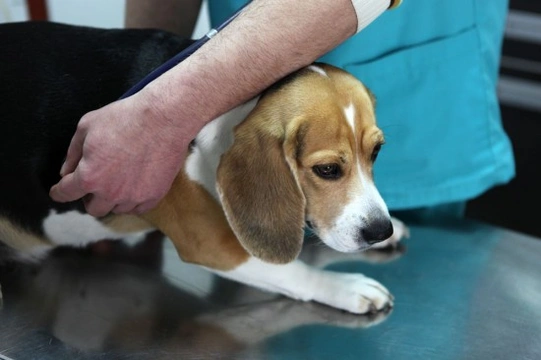
Pyometra in Dogs - Causes, Treatment and Prevention
The term "pyometra" refers to a potentially fatal condition in which the uterus becomes infected and gradually fills with pus. Many dog owners are unaware of this disease, yet veterinary professionals know the signs all too well: behavioural changes including lethargy, increased thirst, increased urination and loss of appetite are amongst the earliest symptoms. As the infection festers, abdominal bloating and/or oozing discharge from the vulva may be noticeable. Without prompt veterinary attention, your pet could quickly deteriorate and die from infection or a rupture of the uterine walls. You may be wondering: what causes this horrible condition and why is it so dangerous? How is pyometra treated once it's been diagnosed? How can I prevent my dog from having pyometra? Read on for answers.
Causes and types of Pyometra
Pyometra develops after bacteria infiltrate the uterus through the cervix, which opens during the heat cycle and following pregnancy. Infection can occur in female mammals of any age, but your dog may be especially susceptible if she has not been spayed, is middle aged or older, or regularly receives hormonal treatments (i.e. misalliance injections, heat suppression injections). Bitches that meet one or more of the above criteria should be monitored especially closely in the weeks after their season and/or after giving birth, as they will be most vulnerable at these times.There are three different types of pyometra:
- Closed - this is an extremely dangerous condition in which the closure of the cervix causes pus to pool in the uterus with no escape. As this happens your dog may become increasingly "off" and her symptoms may worsen over a short period of time. Because there is no discharge and other symptoms of infection aren't easily noticeable, owners may decide to wait it out before seeking veterinary attention. Unfortunately, this increases the risk that uterus will continuously expand and eventually rupture within the body, or that the kidneys will fail. Up to 1/3 of pyometra victims will fall into this category.
- Open - this type of pyometra occurs when the cervix remains open following infection. There will usually be tell-tale discharge around the vulva, however this can easily be mistaken as a continuation of the heat cycle. Though the uterus may not swell or expand, an open pyometra is still classed as an emergency due to the threat of organ damage - especially to the kidneys. The sooner your pet receives veterinary attention the better the prognosis will be.
- Stump- though rare, a stump pyometra is dangerous in that it is often unexpected: it occurs in spayed animals. Unbeknownst to many owners, stump infections may occur in remnants of tissue left behind during a routine spay, which fill with infected fluid. The symptoms and risks are similar to those of a true pyometra, therefore it is important that owners of spayed pets consult their vet as soon as any of the previously-mentioned symptoms crop up.
Uterine infections are dangerous not only because they may cause the uterus to rupture, but also due to the effect they have on the organs - especially the kidneys. Bitches experiencing a uterine infection will drink more water as the formation of immune complexes reduces the ability of the kidneys to absorb water. The result is dehydration, which in and of itself is a considerable health threat, and the risk of eventual kidney or renal failure. This fact plays a role in the type of treatment your pet will receive, as will be discussed in the next section.
Pyometra Treatment
The most common form of treatment for pyometra is an emergency ovariohysterectomy or spay, meaning that the veterinary surgeon will remove the ovaries and uterus to prevent the latter from rupturing. Before a positive diagnosis is made, your vet will need to examine your bitch to determine whether the cervix is open or closed, as well as how advanced the infection has become. The condition of your pet will determine the next step. In some instances, your vet will make the diagnosis just by feeling the dog's uterus through her abdomen, but ultrasound and x-ray may also be used. Sometimes blood tests will be run in order to confirm the presence of white blood cells - a hallmark of infection. If the infection is caught early enough it may be possible to treat it medically with antibiotics. In severe cases, the patient will go straight to the operating prep room post-diagnosis, day or night. A successful spay at this phase is not synonymous with survival: advanced infection may damage the vital organs to the extent that they never recover. Therefore, your vet will take necessary precautions to ensure that your pet is protected from the effects of the anaesthetic agents and surgery itself.As you probably will have guessed, emergency veterinary surgery is far more expensive than a routine spay.The following factors may influence your final bill for treatment:
- Drugs
- Pet weight
- Diagnostic tests
- Anaesthetic agents
- IV fluids
- Hospitalisation
- Suture materials used
- Any follow-up treatment required
If you need to use an emergency or out-of-hours service, the total expense could go up exponentially. In all, you may be looking at a bill that ranges from hundreds to thousands of pounds. Those with pet insurance should read their policy notes carefully in order to ensure they are covered in the event of pyometra.
Prevention of Pyometra
The good news is that pyometra is preventable. If your dog is successfully spayed before her first season, she will be best protected from this and many other reproductive diseases. It is also worth considering that a young, healthy dog is more likely to have an easy recovery than an older bitch following a spay operation. Owners of breeding bitches can still protect their valuable pets by tracking their seasons and closely monitoring any changes in behaviour.



